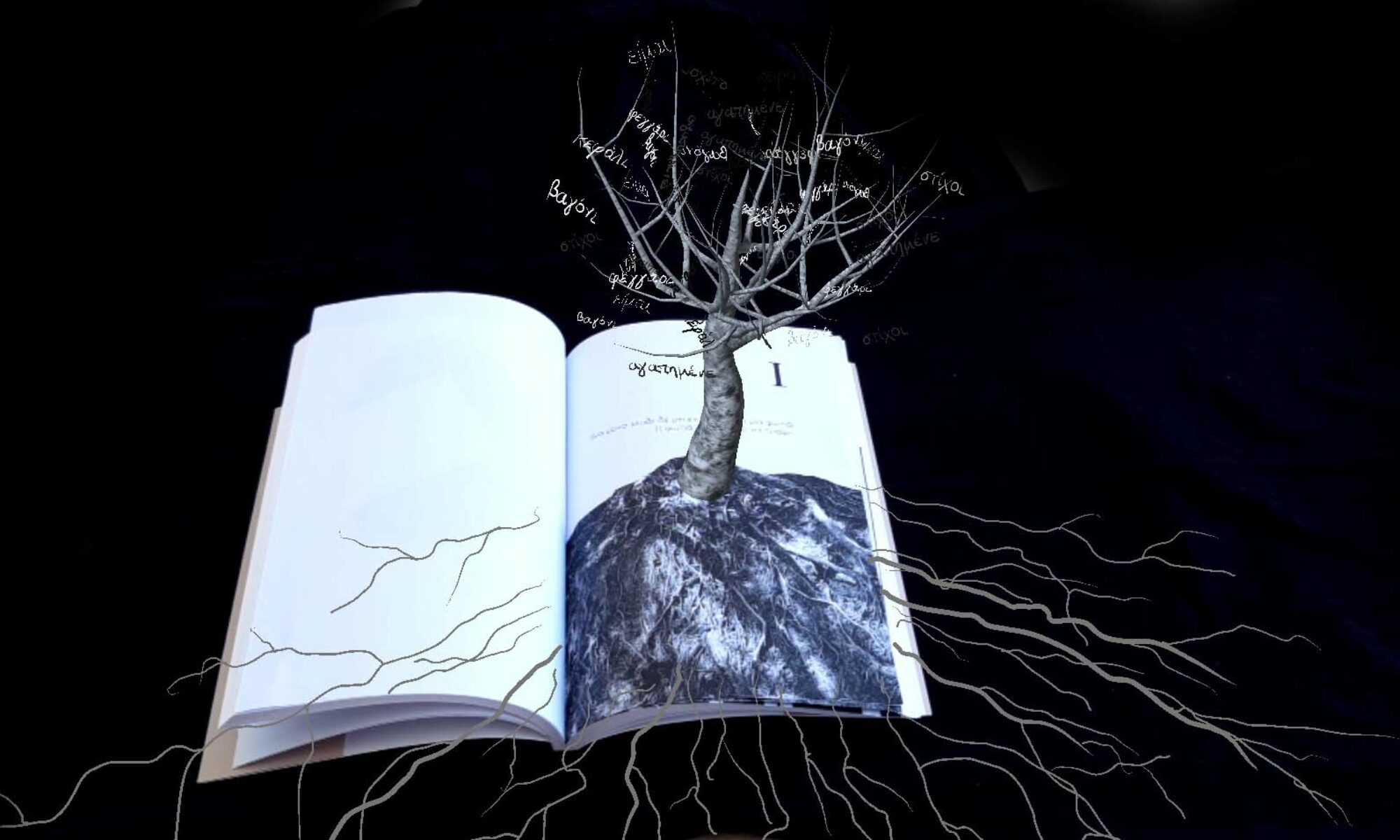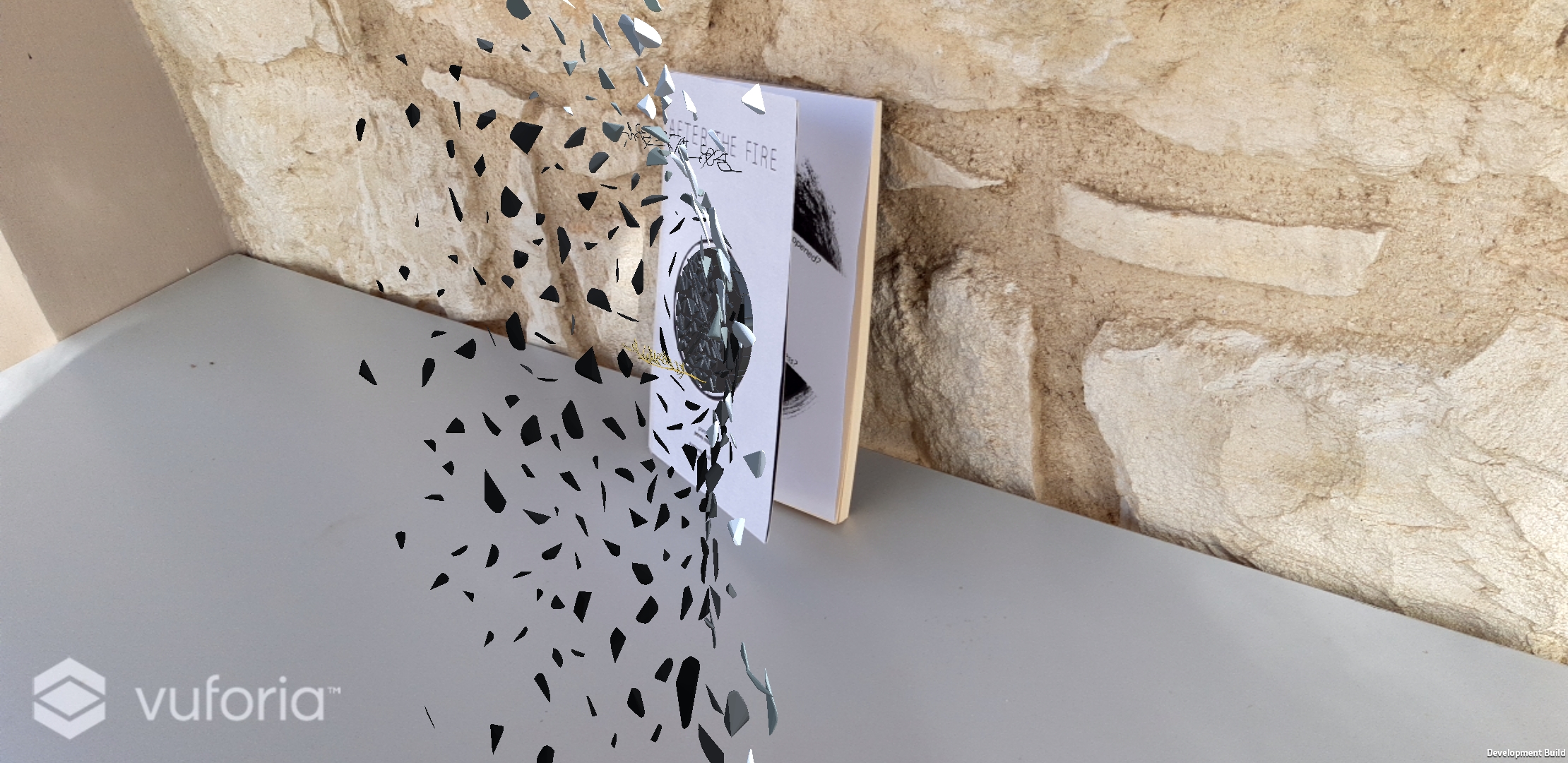“books do not contain life, but its ashes”
Marguerite Yourcenar
After the fire is the first poetry book in Greece utilizing Augmented Reality technology .
Actualising a persistent wish and following their love for innovation and experiment, the poet Penny Milia and the artist Anna Meli worked together with the aim to create a poetry book with an equally powerful visual, namely digital imprint.
The cover of the book and the six images are enriched with original three-dimensional art, both visual and textual, that come alive both in Greek and in English through the screen of your smart device via the application available on the pennymiliawriting.com website.
Can the two timeless arts co-star? Where do tradition and innovation cross?
We married Poetry, an art as old as water, with the latest Technology, and that in the minds of many may sound like an odd couple. But the couple is actually the same age: it is the Visual Arts – that is, in fact equally ancient, perhaps even older, than Poetry – the most advanced digital technological means, which meet in their most modern version.
The idea was for the modern and the primordial to coexist and be intertwined, depicted through the use of technology- just as in the poetry collection there are great contrasts and compositions: the old and the new, the primitive-archetypal and the innovative, the traditional and the experimental, the timeless and the modern.
Themes of postmodern poetry and mainly free verse and dialogue-dreamy writing (gaps, strangeness in rhyme, elliptic verses, viva voce, digressions) form interesting compositions of primitive-classical-archetypal elements, creating augmented reality art images with timeless and powerful universal symbols, such as e.g. fire, with a reversal that enhances counterpoint and matching, using the most innovative book illustration technology nowadays.
Three-dimensional works, starting from the two-dimensional logic of the page of a book or a photograph, expand into the space outside and around the book, like key notes, like drawings cut from the same paper, like living words-images-symbols that come alive in a body and move right before our eyes, like dreams. They come from the depths of Space and Time to meet with us, alive Here and Now, to breathe with us in the same primordial and timeless Rhythm.
Augmented reality Art means Space, consequently Time. The Poem – or its dream – is not static or soundless. If it is three dimensional, it is alive. If it is alive, it has a body. If it has a body, it moves. If it has a body, it also has a voice. The key element that eventually caught us was Rhythm, “the simple punctuation of insignificant and repetitive incisions” (Roland Barthes, “The pleasure of the text”).
The target became very specific: to reflect the overall feeling, the poetic space, where the poems were born, grew up and live as a composition and “stories” at the same time. The poet chose for the book the ones, that resonate and reflect a common atmosphere, that move in a common rhythm. The artist has created an environment, a habitat, that does not simply frame meanings and words but transforms them into shapes and visualized symbols. We chose elements and forms that unite, subtly but also openly, the three basic elements of the book: the poems -as words, ideas and stories- the printed images of the book, where the digital works “nest”, and the three-dimensional visual environment -images , shapes, colors and movement rate.
Thus Rhythm – e.g, how fast or slow the birds will fly and in what shape, or how, in what direction and with what inclination the augmented verse will rotate – became the catalyst. It is ritualistic, dreamy and archetypal, in accordance with the chore aesthetics chosen for the book as a unity. By this criterion, the visual experience is not just aesthetically original or beautiful or true to the prototype, but primarily in an organic relation with the poems as well as with the printed images.
Even initially selected symbols or ideas were modified to keep up with the conceptual and ideological palette of the collection and some new symbols and movements were introduced to support mainly the ritual-performance concept of the project.
Throughout our work, there was a sense that the creation related more to a setting for filming than to a digital illustration. This augmented illustration can be considered as a digital, predetermined repetitive representation of linear and verbal figures that act on the pages of the form. As a form of directing connected in some way with the concept of pocket-theater and performance. Both visual elements and writing were used and each page was treated as a stand-alone scene, with great attention to the “visual” rhythm, similar to an optical sound. Special care were given to the harmonious or counterpoint selection of the images, shapes and rhythm that these would appear, dissapear and move throughout the scenes. The poetic, dreamy and symbolic aspect is stressed and the flowing, flying or levitation effect is strong. The poems might not produce actual sound but you can “hear” their “voice”, augmented in space and volume, in the world created After the fire.
Ⓒ Penny Milia, with data from the Phd thesis of Anna Meli* (Athens School of Fine Arts).
*Anna Meli, born in Athens in 1986, is a new media artist and researcher. She has completed her PhD at Athens School of Fine Arts (ASFA) Greece in 2021. In 2015 she completed the European Master entitled “Art, virtual reality and multiuser systems of artistic expression” (ASFA and University Paris 8) and in 2010 she graduated from ASFA with the degree in painting. Her work is a combination of typography and new media, based on narration and interactivity. She has participated in international conferences and exhibitions. Since 2015 she is artistic director at Artemis Studio in Ikaria, Greece.

